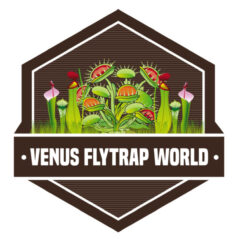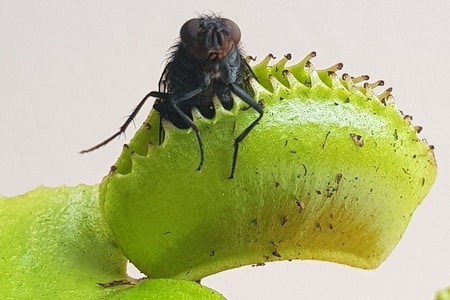Venus flytraps capture insects with their leaves and consume them to obtain essential nutrients. Sometimes when a Venus flytrap eats, some of its leaves might start to wither or turn black. Are black leaves a cause of feeding them?
In general, Venus flytraps can consume bugs multiple times without losing leaves. However, Venus flytraps exhibit black leaves after feeding if the bug is too big or difficult to digest. Properly feeding Venus flytraps can significantly reduce the number of black leaves.
In this article, you will learn about the feeding process and how to avoid black leaves that can end up weakening your plant.
Do Venus Flytraps Die After Eating?
Venus flytraps have developed advanced mechanisms to capture and consume bugs. Their predatory abilities are critical to their wellbeing.
Venus flytraps do not die after eating. Still, leaves can turn black due to age or after capturing prey that is too large in size or difficult to digest. Black leaves are normal in Venus flytraps. However, in some cases, they can be a warning sign of poor growing conditions.
When Venus flytraps get black leaves, the black leaves do not spread through the plant. Every leaf will wither when it is time, and as one leaf withers, a new one should start spurring from the center.
If you have recently fed your plant, and now some leaves are dying, here is some advice:
Sometimes leaves wither due to old age. Do not get alarmed every single time you spot a black leaf. Only consider making changes if you notice there is a sudden increase in black leaves.
If you noticed that your Venus flytrap loses leaves every time you feed it, stop for a little while. Making mistakes during the feeding process is standard, as Venus flytraps are very particular plants.
Take your time to research the process, and then attempt it one more time. When you adjust your method, make sure to monitor the leaves to ensure you are successful.
If the pattern of black leaves persists, consider skipping the feeding altogether. Venus flytraps do not need to consume insects to survive. The nutrients they extract are a supplement, yet not a requirement. Sometimes, the safest option is to stop feeding your plant.
Tips To Avoid Black Leaves After Feeding a Venus Flytrap
Making mistakes during the feeding process can cause black leaves in your plant. Follow these tips to avoid causing them:
- Do not overfeed your Venus flytrap: Venus flytraps do not need to be fed every day or every week. Feed your plant only once every 3 to 6 weeks. Also, when feeding the plant, only feed one single trap of the whole plant.
- Choose the right size bug: Employ a bug that can fit entirely inside your plant’s trap. When bugs are too big, venus flytraps give up digesting them and end up withering. As a general rule, employ a bug that is no larger than 1/3 of the trap’s size.
- Avoid insects with hard shells: venus flytraps can consume a wide variety of insects and spiders. However, some bugs might be too hard to digest due to their shell or thick exoskeleton. Avoid hard shell bugs such as battles or snails, instead consider soft mealworms, crickets, or flies.
- Do not play with the traps: When feeding or caring for venus flytraps, you might trigger the traps accidentally every once in a while. That is ok. However, playing with the traps by activating them can end up killing them.
- Skip the feeding process during dormancy: When Venus flytraps are dormant, they do not need to be fed. In the winter months, do not feed your Venus flytrap. Causing black leaves during dormancy can be dangerous.
- Place your Venus flytrap outside: When Venus flytraps live outdoors, they can capture plenty of bugs independently. If you let your plant capture its own prey, the number of black leaves can reduce significantly.
- Consider live feed vs. dead bugs: Generally, you can choose between live or dead prey to feed your plant. However, employing dead bugs requires some extra involvement. Use live prey to avoid bruising the traps and causing brown leaves.
The tips in this section are very important, but there is a lot more to learn about the Venus flytrap feeding process. This guide: How to Feed a Venus Flytrap – A Complete Guide with Pictures, can help you understand the process step by step.
Learn step-by-step how to feed Venus flytraps. This video demonstrates multiple times how to use live insects to feed your carnivorous plant. Also, it includes tips to feed your plant without causing black leaves and harming it.
Do Venus Fly Traps Die After They Close?
In the wild, Venus flytraps grow in nutrient-poor areas. As a result, they have evolved to be capable of capturing and consuming bugs. They consume bugs to extract key nutrients and supplement their diet.
The leaves of a Venus flytrap are equipped with trigger hairs. When an insect comes in contact with those thin filaments inside the traps, the trap closes.
Venus flytraps can open and close between 3 to 7 times before their traps start to wither. Then, the trap will be exhausted; it will stop working and eventually turn black. Venus flytraps do not die after closing, but their leaves wither after closing multiple times.
The traps of Venus flytraps can open and close multiple times before they start to wither. Once the trap has been triggered multiple times, it will start turning black.
If you are interested in the science behind Venus flytraps, learn more about the trapping mechanisms with this article: When Do Venus Flytrap Open and Close? Trapping Mechanisms.
What Happens to a Venus Fly Trap After It Eats?
When Venus flytraps capture a bug, they close their traps and enclose them in their leaves.
As the bug moves around inside the trap and tries to escape, the plant starts to produce digestive enzymes. At this point, the trap is fully closed, and the bug is completely trapped in the leaf.
The digestive enzymes fill up the leaf completely. The traps act as an exterior stomach, in a way. The digestive enzymes will start breaking up the bug for digestion.
The insect does not have a slow deaf being digested inside the trap; it ends up drowning pretty quickly as the leaf pumps the enzymes.
Venus flytraps take several days or weeks to consume a single bug.
Sometimes, the bug captured by the plant might be difficult to digest. In those cases, the plant might give up consuming the bug and let that leaf wither. One leaf will wither, but the plant will remain healthy.
If the plant is successful at consuming the prey, the leaf should reopen after a couple of weeks. The plant is able to consume all the soft tissue from the insect, but it will leave some matter behind.
When the leaf reopens, you can often observe the dry exoskeleton from the insect.
A single leaf can complete the digestion process multiple times before withering due to age. Also, multiple leaves from the same plant can consume bugs simultaneously.
I hope you found this article to be useful. For more information on Venus flytrap care (including black leaves), you can read this detailed guide: Ultimate Venus Flytrap Care Guide – Free Care Sheet Included. If you are considering growing Venus flytraps indoors, this article can help you build the right setup: Venus Flytrap Indoor Care Guide.


